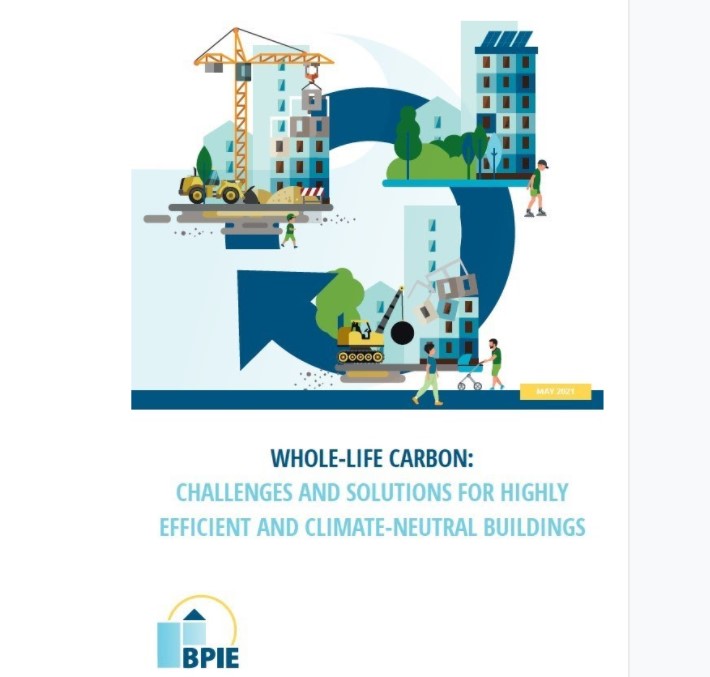BPIE report urges EU to incorporate the carbon footprint of construction into policy

|
Contents |
[edit] Introduction
Research from the Buildings Performance Institute Europe (BPIE) published in May 2021, suggests that while some European Union members have introduced comprehensive policies to reduce the carbon footprint of buildings and construction, this should now be coordinated and regulated at the European level.
The report 'Introducing whole-life carbon metrics: Recommendations for highly efficient and climate-neutral buildings', stresses how the EU's legislative changes for buildings and construction are a critical opportunity to create policy and investment certainty about carbon performance rules.
[edit] EU environmental goals
The EU aims to be climate neutral by 2050, requiring a fundamental transformation of the construction industry. Direct building CO2 emissions need to more than halve by 2030 to be on track for the 2050 target.
In its Renovation Wave strategy, the European Commission announced its intention to introduce a '2050 whole life-cycle performance roadmap' to reduce carbon emissions from buildings' by 2023.
Oliver Rapf, Executive Director of BPIE said,"For new buildings built to the highest energy efficiency standards, the low operational energy demand means that embodied carbon becomes the most significant source of carbon emissions over the building's lifetime.”
Embodied carbon emissions are associated with energy consumption and chemical processes during raw material extraction, manufacture, transportation, assembly, replacement, construction, demolition and disposal, accounting for approximately 10% to 20% of EU buildings' CO2 footprint.
To address this, BPIE suggests a common EU approach to whole-life carbon (WLC) emissions. This will require better coordination across policy measures addressing and affecting the different stages of the construction value chain.
[edit] Recalibrating targets
In the report, the BPIE finds that the introduction of a '2050 whole life-cycle performance roadmap', scheduled for 2023, is out of sync with the current legislative review process.
Rapf said, "Policy action taken by a number of EU member states demonstrates that whole-life carbon policies are possible and desirable. The European Commission should reflect this in its forthcoming proposals in 2021 (for example of the Energy Performance of Buildings Directive and the Energy Efficiency Directive), to make sure that we don't lose time in the fight against climate change".
[edit] Related articles on Designing Buildings
- Buildings Performance Institute Europe BPIE.
- Carbon neutral buildings.
- Embodied carbon.
- Energy Performance of Buildings Directive.
- EU Referendum - Environmental and climate change consequences for the built environment.
- Europe.
- Net zero carbon 2050.
- New European Bauhaus.
- Renovation Wave Strategy RWS.
Featured articles and news
Ebenezer Howard: inventor of the garden city. Book review.
The Grenfell Tower fire, eight years on
A time to pause and reflect as Dubai tower block fire reported just before anniversary.
Airtightness Topic Guide BSRIA TG 27/2025
Explaining the basics of airtightness, what it is, why it's important, when it's required and how it's carried out.
Construction contract awards hit lowest point of 2025
Plummeting for second consecutive month, intensifying concerns for housing and infrastructure goals.
Understanding Mental Health in the Built Environment 2025
Examining the state of mental health in construction, shedding light on levels of stress, anxiety and depression.
The benefits of engaging with insulation manufacturers
When considering ground floor constructions.
Lighting Industry endorses Blueprint for Electrification
The Lighting Industry Association fully supports the ECA Blueprint as a timely, urgent call to action.
BSRIA Sentinel Clerk of Works Training Case Study
Strengthening expertise to enhance service delivery with integrated cutting-edge industry knowledge.
Impact report from the Supply Chain Sustainability School
Free sustainability skills, training and support delivered to thousands of UK companies to help cut carbon.
The Building Safety Forum at the Installershow 2025
With speakers confirmed for 24 June as part of Building Safety Week.
The UK’s largest air pollution campaign.
Future Homes Standard, now includes solar, but what else?
Will the new standard, due to in the Autumn, go far enough in terms of performance ?
BSRIA Briefing: Cleaner Air, Better tomorrow
A look back at issues relating to inside and outside air quality, discussed during the BSRIA briefing in 2023.
Restoring Abbotsford's hothouse
Bringing the writer Walter Scott's garden to life.
Reflections on the spending review with CIAT.
Retired firefighter cycles world to raise Grenfell funds
Leaving on 14 June 2025 Stephen will raise money for youth and schools through the Grenfell Foundation.
Key points for construction at a glance with industry reactions.






















